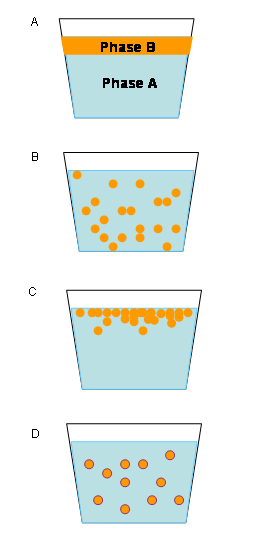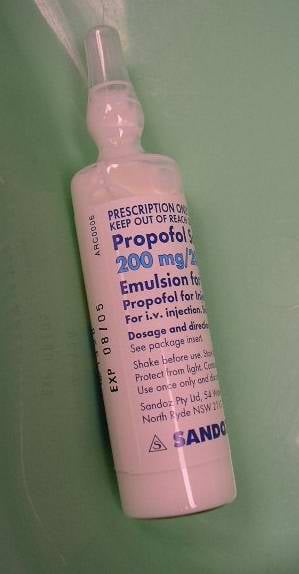Emulsion
An emulsion is a mixture of two immiscible (unblendable) substances. One substance (the dispersed phase) is dispersed in the other (the continuous phase). Examples of emulsions include butter and margarine, espresso, mayonnaise, the photo-sensitive side of Photographic film, and cutting fluid for metalworking. In butter and margarine, a continuous lipid phase surrounds droplets of water (water-in-oil emulsion). Emulsification is the process by which emulsions are prepared.
Emulsions tend to have a cloudy appearance, because the many phase interfaces (the boundary between the phases is called the interface) scatter light that passes through the emulsion. Emulsions are unstable and thus do not form spontaneously. Energy input through shaking, stirring, homogenizers, or spray processes are needed to form an emulsion. Over time, emulsions tend to revert to the stable state of oil separated from water. Surface active substances (surfactants) can increase the kinetic stability of emulsions greatly so that, once formed, the emulsion does not change significantly over years of storage. Homemade oil and vinegar salad dressing is an example of an unstable emulsion that will quickly separate unless shaken continuously. This phenomenon is called coalescence, and happens when small droplets recombine to form bigger ones. Fluid emulsions can also suffer from creaming, the migration of one of the substances to the top of the emulsion under the influence of buoyancy or centripetal force when a centrifuge is used.
Emulsions are part of a more general class of two-phase systems of matter called colloids. Although the terms colloid and emulsion are sometimes used interchangeably, emulsion tends to imply that both the dispersed and the continuous phase are liquid.
There are three types of emulsion instability: flocculation, where the particles form clumps; creaming, where the particles concentrate towards the surface of the mixture while staying separated; and breaking, where the particles coalesce and form a layer of liquid.
Emulsifier
An emulsifier (also known as an emulgent or surfactant) is a substance which stabilizes an emulsion. Examples of food emulsifiers are egg yolk (where the main emulsifying chemical is the phospholipid lecithin), and mustard, where a variety of chemicals in the mucilage surrounding the seed hull act as emulsifiers; proteins and low-molecular weight emulsifiers are common as well. In some cases, particles can stabilise emulsions as well through a mechanism called Pickering stabilization. Both mayonnaise and Hollandaise sauce are oil-in-water emulsions stabilized with egg yolk lecithin. Detergents are another class of surfactant, and will chemically interact with both oil and water, thus stabilising the interface between oil or water droplets in suspension. This principle is exploited in soap to remove grease for the purpose of cleaning. A wide variety of emulsifiers are used in pharmacy to prepare emulsions such as creams and lotions.
Whether an emulsion turns into a water-in-oil emulsion or an oil-in-water emulsion depends on the volume fraction of both phases and on the type of emulsifier. Generally, the Bancroft rule applies: emulsifiers and emulsifying particles tend to promote dispersion of the phase in which they do not dissolve very well; for example, proteins dissolve better in water than in oil and so tend to form oil-in-water emulsions (that is they promote the dispersion of oil droplets throughout a continuous phase of water).
bs:Emulzija ca:Emulsió da:Emulsion de:Emulsion et:Emulsioon es:Emulsión fr:Émulsion it:Emulsione he:חומר מתחלב nl:Emulsie no:Emulsjon ja:エマルション pl:Emulsja pt:Emulsão ru:Эмульсия sr:Емулзија fi:Emulsio sv:Emulsion vi:Nhũ tương zh:乳剂

